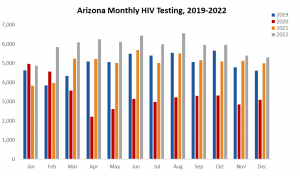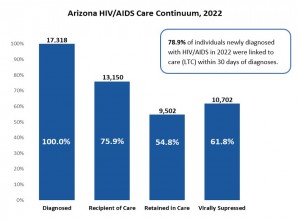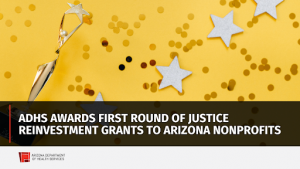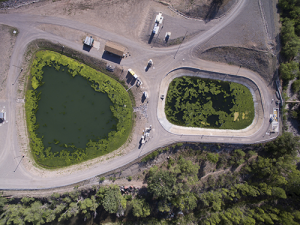New HIV cases increased over the past year and so has access to services for those who need them. The rise in cases follows a dip in newly diagnosed cases due to reduced testing during COVID-19 lockdowns and mitigation...
 New HIV cases increased over the past year and so has access to services for those who need them. The rise in cases follows a dip in newly diagnosed cases due to reduced testing during COVID-19 lockdowns and mitigation measures.
New HIV cases increased over the past year and so has access to services for those who need them. The rise in cases follows a dip in newly diagnosed cases due to reduced testing during COVID-19 lockdowns and mitigation measures.
The HIV Surveillance program’s latest Annual Report shows there were 975 new cases in 2022 in Arizona, representing an increase of 20 percent. However, the state’s HIV linkage to care systems was able to rapidly provide more support to people who are newly diagnosed, connecting 79% of all those in Arizona diagnosed with HIV to services within 30 days of diagnosis.
The state’s HIV prevention and care systems remain focused on educating the public and providers on HIV, preventing new HIV infections, and working with statewide partners to quickly connect patients with treatment.
Despite scientific advancements in the prevention and treatment of HIV (notably the use of pre-exposure prophylaxis (PrEP) for HIV prevention and increased use of antiretroviral therapy (ART) for HIV care), there’s an ongoing need for public health efforts to mitigate the spread of HIV and AIDS in Arizona as well as enhance support for those affected by HIV.
Each year, the ADHS HIV Surveillance Program produces an annual report that describes the characteristics of people living with HIV and AIDS in Arizona. The Annual Report is a valuable tool used by ADHS, local health departments, and community stakeholders to inform HIV prevention initiatives and effective responses to the HIV epidemic. To view the report and other data dashboards, please visit ADHS’ HIV Surveillance page.
The 2023 Annual Report documents HIV incidence and prevalence trends at both the state and county levels, and offers a detailed analysis of sociodemographic, geographic, and behavioral factors associated with HIV/AIDS as well as the health outcomes among people living with HIV and AIDS. By the end of 2022, there were 19,894 people living with HIV and AIDS in Arizona. ADHS conducts ongoing data-matching with other states to ensure this number accurately reflects the Arizona population at the end of the calendar year. Highlights from the 2023 Annual Report include:
Increased incident cases and increased HIV testingFrom 2021 to 2022, there was a 20% increase in incident cases reported. However, there was also a 19% increase in publicly-funded HIV testing in 2022 compared to 2019, with more than 70,000 tests reported in 2022.
 After a reduction in HIV testing activities during the COVID-19 pandemic, there has been a consistent upward trend in HIV testing since 2020, with higher testing numbers recorded in the 2021 and 2022.
Populations at greater risk and disparities in outcomes:
After a reduction in HIV testing activities during the COVID-19 pandemic, there has been a consistent upward trend in HIV testing since 2020, with higher testing numbers recorded in the 2021 and 2022.
Populations at greater risk and disparities in outcomes: Certain populations are still at an increased risk for more severe outcomes. A few key data points in the report are: 86% of new HIV and AIDS diagnoses from 2022 were among people assigned male at birth. Men who have sex with men was the most commonly reported risk behavior for newly diagnosed HIV cases, with 56% of the incident cases reporting MSM. By age, the highest HIV and AIDS incidence rates were among people aged 30 to 34 years old (33.4 cases per 100,000) and people aged 25 to 29 years old (31.9 cases per 100,000). The group with the greatest number of new HIV and AIDS cases was the Hispanic population, who accounted for 405 of the 975 new cases in 2022. Continuum of Care
 In 2022, 79% of people diagnosed with HIV/AIDS were linked to care within 30 days of their diagnosis and following treatment, 61.8% were virally suppressed, which means that a person with HIV has such a low viral load that they are able to stay healthy, and they will not transmit HIV to their sex partners. People with HIV can become and stay virally suppressed by regularly taking antiretroviral (ARV) medications to treat their HIV.
Improvements in care
In 2022, 79% of people diagnosed with HIV/AIDS were linked to care within 30 days of their diagnosis and following treatment, 61.8% were virally suppressed, which means that a person with HIV has such a low viral load that they are able to stay healthy, and they will not transmit HIV to their sex partners. People with HIV can become and stay virally suppressed by regularly taking antiretroviral (ARV) medications to treat their HIV.
Improvements in careThe American Indian/Alaskan Native (AI/AN) population had the highest treatment adherence across all stages of the HIV continuum of care. Among AI/AN PLWH, 82% received care, 74% were retained in care and 69% were virally suppressed.
The ADHS HIV Surveillance Program values the community’s input. The program is planning to reach out to community partners in early 2024 to gather feedback on the 2023 HIV and AIDS Annual Report. This feedback will help to enhance the Annual Report’s quality and allow the HIV Surveillance Program to better serve the community.
If you are interested in providing feedback, please subscribe to the monthly HIV newsletter where we will disseminate the survey link. To subscribe, use this link and select the “Ryan White Part B (RWPB) & Prevention” topic listed under Preparedness.
Have additional questions? Please email the Office of HIV and Hepatitis C Services (OHHS) at OHHSTA@azdhs.gov












